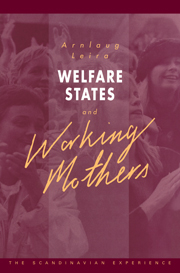Book contents
- Frontmatter
- Contents
- List of figures
- List of tables
- Preface and acknowledgements
- List of abbreviations
- 1 Introduction
- 2 Models of motherhood
- 3 Welfare states and working mothers: the Scandinavian experience
- 4 The collectivization of childcare
- 5 Mothers, markets and the state
- 6 Modes of mothering
- 7 Carer state and carer careers
- Notes
- References
- Index
5 - Mothers, markets and the state
Published online by Cambridge University Press: 05 December 2011
- Frontmatter
- Contents
- List of figures
- List of tables
- Preface and acknowledgements
- List of abbreviations
- 1 Introduction
- 2 Models of motherhood
- 3 Welfare states and working mothers: the Scandinavian experience
- 4 The collectivization of childcare
- 5 Mothers, markets and the state
- 6 Modes of mothering
- 7 Carer state and carer careers
- Notes
- References
- Index
Summary
The ‘modernization’ of motherhood
The generation of Norwegian women born in the first decades after World War II came to introduce new models of behaviour in almost all fields of everyday life. The most dramatic changes are seen in new approaches to motherhood. The ‘modernization’ of motherhood encompasses women's increased control over fertility and social reproduction; it is manifested in family and everyday life, and in economic and political participation.
Figures do not in themselves give the content and meaning or the quality of social change. Yet, excerpts from the basic statistics of 1960 and of 1990 do give an indication of some of the structural changes to which women have contributed, and which in turn present new frames for women's lives. Figure 5.1 illustrates some of the striking new trends. In Norway as elsewhere in the Western industrialized societies, women of the 1970s gained a degree of reproductive control unknown to earlier generations. The use of oral contraceptives and the right to legal abortion, on demand from 1978, gave women a control over pregnancies and births that has had far-reaching influence on adult women's lives. A greater proportion of women actually have become mothers in the 1980s than in earlier decades, but the number of children per mother is greatly reduced. Shortening the span of the child-bearing and rearing years and increasing education have facilitated women's employment.
Labour market participation obviously is more important to women of the 1980s than to their mothers.
- Type
- Chapter
- Information
- Welfare States and Working MothersThe Scandinavian Experience, pp. 97 - 131Publisher: Cambridge University PressPrint publication year: 1992

